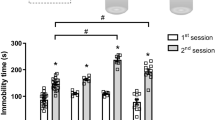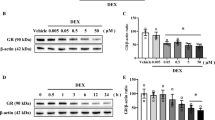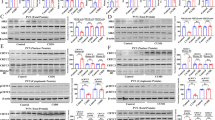Abstract
Rationale
The decrease of astrocyte number and hypothalamic-pituitary-adrenal (HPA) axis overactivity are observed in individuals with major depressive disorder. Elevated levels of glucocorticoids induced by hyperactivation of the HPA axis may result in glucocorticoid receptor (GR) activation. However, it is unclear whether there is a direct link between GR activation and the decrease of astrocyte number.
Methods
Animals were exposed to chronic unpredictable stress (CUS) for 28 days and treated with continuous subcutaneous injections of vehicle or corticosterone (CORT; 40 mg/kg/day) for 21 days. We then administered mifepristone on day 21 after CUS and on day 18 after the CORT treatment. We observed behavioral deficits in the sucrose preference test, open field test, and forced swim test. Protein expression was analyzed using immunofluorescence (IF) and western blot (WB).
Results
Animals exposed to CUS exhibited behavioral deficits in tests measuring anhedonia, anxiety, and despair state. They also had decreases in glial fibrillary acidic protein (GFAP) expression and numbers of GFAP-positive cells in the hippocampus. The behavioral and cellular alterations induced by CUS were reversed by subchronic treatment with the GR antagonist mifepristone. We also found that the subcutaneous injection of glucocorticoids may induce depression-like behavior and reduce GFAP protein expression in rats, which was similarly reversed by mifepristone.
Conclusions
These findings provide experimental evidence that GR activation due to elevated CORT levels induces the decrease of hippocampal astrocyte number in rats.








Similar content being viewed by others
References
Anacker C, Zunszain PA, Carvalho LA, Pariante CM (2011) The glucocorticoid receptor: pivot of depression and of antidepressant treatment? Psychoneuroendocrinology 36:415–425
Anthes E (2014) Depression: a change of mind. Nature 515:185–187
Araya-Callis C, Hiemke C, Abumaria N, Flugge G (2012) Chronic psychosocial stress and citalopram modulate the expression of the glial proteins GFAP and NDRG2 in the hippocampus. Psychopharmacology 224:209–222
Banasr M, Duman RS (2008) Glial loss in the prefrontal cortex is sufficient to induce depressive-like behaviors. Biol Psychiatry 64:863–870
Banasr M, Valentine GW, Li X-Y, Gourley SL, Taylor JR, Duman RS (2007) Chronic Unpredictable Stress Decreases Cell Proliferation in the Cerebral Cortex of the Adult Rat. Biol Psychiatry 62:496–504
Banasr M, Chowdhury GM, Terwilliger R, Newton SS, Duman RS, Behar KL, Sanacora G (2010) Glial pathology in an animal model of depression: reversal of stress-induced cellular, metabolic and behavioral deficits by the glutamate-modulating drug riluzole. Mol Psychiatry 15:501–511
Belanoff JK, Flores BH, Kalezhan M, Sund B, Schatzberg AF (2001) Rapid reversal of psychotic depression using mifepristone. J Clin Psychopharmacol 21:516–521
Belanoff JK, Rothschild AJ, Cassidy F, DeBattista C, Baulieu E-E, Schold C, Schatzberg AF (2002) An open label trial of C-1073 (mifepristone) for psychotic major depression*. Biol Psychiatry 52:386–392
Bener D, Wohlman A, Itzik A, Yirmiya R, Ben-Hur T, Weidenfeld J (2007) Glucocorticoid resistance following herpes simplex-1 infection: role of hippocampal glucocorticoid receptors. Neuroendocrinology 85:207–215
Blasey CM, Block TS, Belanoff JK, Roe RL (2011) Efficacy and safety of mifepristone for the treatment of psychotic depression. J Clin Psychopharmacol 31:436–440
Boldrini M, Underwood MD, Hen R, Rosoklija GB, Dwork AJ, John Mann J, Arango V (2009) Antidepressants increase neural progenitor cells in the human hippocampus. Neuropsychopharmacology 34:2376–2389
Carroll BJ, Rubin RT (2006) Is mifepristone useful in psychotic depression? Neuropsychopharmacology 31:2793–2794 author reply 2795-7
Cheng T, Dimitrov S, Pruitt C, Hong S (2016) Glucocorticoid mediated regulation of inflammation in human monocytes is associated with depressive mood and obesity. Psychoneuroendocrinology 66:195–204
Chijiwa T, Oka T, Lkhagvasuren B, Yoshihara K, Sudo N (2015) Prior chronic stress induces persistent polyI:C-induced allodynia and depressive-like behavior in rats: Possible involvement of glucocorticoids and microglia. Physiol Behav 147:264–273
Czeh B, Di Benedetto B (2013) Antidepressants act directly on astrocytes: evidences and functional consequences. European neuropsychopharmacology: the journal of the European College of. Neuropsychopharmacology 23:171–185
Czeh B, Simon M, Schmelting B, Hiemke C, Fuchs E (2006) Astroglial plasticity in the hippocampus is affected by chronic psychosocial stress and concomitant fluoxetine treatment. Neuropsychopharmacology: official publication of the American College of. Neuropsychopharmacology 31:1616–1626
Datson NA, Speksnijder N, Mayer JL, Steenbergen PJ, Korobko O, Goeman J, de Kloet ER, Joels M, Lucassen PJ (2012) The transcriptional response to chronic stress and glucocorticoid receptor blockade in the hippocampal dentate gyrus. Hippocampus 22:359–371
DeBattista C, Belanoff J, Glass S, Khan A, Horne RL, Blasey C, Carpenter LL, Alva G (2006) Mifepristone versus placebo in the treatment of psychosis in patients with psychotic major depression. Biol Psychiatry 60:1343–1349
Dirven BCJ, Homberg JR, Kozicz T, Henckens M (2017) Epigenetic programming of the neuroendocrine stress response by adult life stress. J Mol Endocrinol 59:R11–r31
Dong L, Wang S, Li Y, Zhao Z, Shen Y, Liu L, Xu G, Ma C, Li S, Zhang X, Cong B (2017) RU486 Reverses Emotional Disorders by Influencing Astrocytes and Endoplasmic Reticulum Stress in Chronic Restraint Stress Challenged Rats. Cellular physiology and biochemistry: international journal of experimental cellular physiology, biochemistry, and. Pharmacology 42:1098–1108
Fitzsimons CP, Herbert J, Schouten M, Meijer OC, Lucassen PJ, Lightman S (2016) Circadian and ultradian glucocorticoid rhythmicity: Implications for the effects of glucocorticoids on neural stem cells and adult hippocampal neurogenesis. Front Neuroendocrinol 41:44–58
Flores BH, Kenna H, Keller J, Solvason HB, Schatzberg AF (2006) Clinical and biological effects of mifepristone treatment for psychotic depression. Neuropsychopharmacology: official publication of the American College of. Neuropsychopharmacology 31:628–636
Gao SF, Lu YR, Shi LG, Wu XY, Sun B, Fu XY, Luo JH, Bao AM (2014) Nitric oxide synthase and nitric oxide alterations in chronically stressed rats: a model for nitric oxide in major depressive disorder. Psychoneuroendocrinology 47:136–140
Gao L, Guan W, Wang M, Wang H, Yu J, Liu Q, Qiu B, Yu Y, Ping Y, Bian X, Shen L, Pei G (2017) Direct Generation of Human Neuronal Cells from Adult Astrocytes by Small Molecules. Stem Cell Reports 8:538–547
Garcia-Caceres C, Lagunas N, Calmarza-Font I, Azcoitia I, Diz-Chaves Y, Garcia-Segura LM, Baquedano E, Frago LM, Argente J, Chowen JA (2010) Gender differences in the long-term effects of chronic prenatal stress on the HPA axis and hypothalamic structure in rats. Psychoneuroendocrinology 35:1525–1535
Gong MJ, Han B, Wang SM, Liang SW, Zou ZJ (2016) Icariin reverses corticosterone-induced depression-like behavior, decrease in hippocampal brain-derived neurotrophic factor (BDNF) and metabolic network disturbances revealed by NMR-based metabonomics in rats. J Pharm Biomed Anal 123:63–73
Grippo AJ, Francis J, Beltz TG, Felder RB, Johnson AK (2005) Neuroendocrine and cytokine profile of chronic mild stress-induced anhedonia. Physiol Behav 84:697–706
Hamidi M, Drevets WC, Price JL (2004) Glial reduction in amygdala in major depressive disorder is due to oligodendrocytes. Biol Psychiatry 55:563–569
Harrison PJ (2002) The neuropathology of primary mood disorder. Brain J Neurol 125:1428–1449
Hazra S, Kumar S, Saha GK, Mondal AC (2017) Reversion of BDNF, Akt and CREB in Hippocampus of Chronic Unpredictable Stress Induced Rats: Effects of Phytochemical, Bacopa Monnieri. Psychiatry Investig 14:74–80
Hu P, Oomen C, van Dam AM, Wester J, Zhou JN, Joels M, Lucassen PJ (2012) A single-day treatment with mifepristone is sufficient to normalize chronic glucocorticoid induced suppression of hippocampal cell proliferation. PLoS One 7:e46224
Iwata M, Shirayama Y, Ishida H, Hazama GI, Nakagome K (2011) Hippocampal astrocytes are necessary for antidepressant treatment of learned helplessness rats. Hippocampus 21:877–884
Iyo AH, Feyissa AM, Chandran A, Austin MC, Regunathan S, Karolewicz B (2010) Chronic corticosterone administration down-regulates metabotropic glutamate receptor 5 protein expression in the rat hippocampus. Neuroscience 169:1567–1574
Jo WK, Zhang Y, Emrich HM, Dietrich DE (2015) Glia in the cytokine-mediated onset of depression: fine tuning the immune response. Front Cell Neurosci 9:268
Joels M, Karst H, Krugers HJ, Lucassen PJ (2007) Chronic stress: implications for neuronal morphology, function and neurogenesis. Front Neuroendocrinol 28:72–96
Juif PE, Anton F, Hanesch U (2012) Pain behavior and spinal cell activation due to carrageenan-induced inflammation in two inbred rat strains with differential hypothalamic-pituitary-adrenal axis reactivity. Physiol Behav 105:901–908
Kalueff AV, Gallagher PS, Murphy DL (2006) Are serotonin transporter knockout mice ‘depressed’?: hypoactivity but no anhedonia. Neuroreport 17:1347–1351
Karisetty BC, Maitra S, Wahul AB, Musalamadugu A, Khandelwal N, Guntupalli S, Garikapati R, Jhansyrani T, Kumar A, Chakravarty S (2017) Differential effect of chronic stress on mouse hippocampal memory and affective behavior: Role of major ovarian hormones. Behav Brain Res 318:36–44
Karst H, Joels M (2007) Brief RU 38486 treatment normalizes the effects of chronic stress on calcium currents in rat hippocampal CA1 neurons. Neuropsychopharmacology 32:1830–1839
Katz RJ, Roth KA, Carroll BJ (1981) Acute and chronic stress effects on open field activity in the rat: implications for a model of depression. Neurosci Biobehav Rev 5:247–251
Kino T (2015) Stress, glucocorticoid hormones, and hippocampal neural progenitor cells: implications to mood disorders. Front Physiol 6:230
Kott JM, Mooney-Leber SM, Shoubah FA, Brummelte S (2016) Effectiveness of different corticosterone administration methods to elevate corticosterone serum levels, induce depressive-like behavior, and affect neurogenesis levels in female rats. Neuroscience 312:201–214
Krugers HJ, Goltstein PM, van der Linden S, Joels M (2006) Blockade of glucocorticoid receptors rapidly restores hippocampal CA1 synaptic plasticity after exposure to chronic stress. Eur J Neurosci 23:3051–3055
Kvarta MD, Bradbrook KE, Dantrassy HM, Bailey AM, Thompson SM (2015) Corticosterone mediates the synaptic and behavioral effects of chronic stress at rat hippocampal temporoammonic synapses. J Neurophysiol 114:1713–1724
Lante F, Chafai M, Raymond EF, Pereira AR, Mouska X, Kootar S, Barik J, Bethus I, Marie H (2015) Subchronic glucocorticoid receptor inhibition rescues early episodic memory and synaptic plasticity deficits in a mouse model of Alzheimer's disease. Neuropsychopharmacology 40:1772–1781
Lenk K, Raisanen E, Hyttinen JA, Lenk K, Raisanen E, Hyttinen JA, Lenk K, Hyttinen JA, Raisanen E (2016) Understanding the role of astrocytic GABA in simulated neural networks. Conference proceedings: Annual International Conference of the IEEE Engineering in Medicine and Biology Society IEEE Engineering in Medicine and Biology Society Annual Conference 2016: 6121-6124.
Li LF, Yang J, Ma SP, Qu R (2013) Magnolol treatment reversed the glial pathology in an unpredictable chronic mild stress-induced rat model of depression. Eur J Pharmacol 711:42–49
Liu Q, Li B, Zhu HY, Wang YQ, Yu J, Wu GC (2009) Clomipramine treatment reversed the glial pathology in a chronic unpredictable stress-induced rat model of depression. Eur Neuropsychopharmacol 19:796–805
Liu Q, Li B, Zhu HY, Wang YQ, Yu J, Wu GC (2011) Glia atrophy in the hippocampus of chronic unpredictable stress-induced depression model rats is reversed by electroacupuncture treatment. J Affect Disord 128:309–313
Lucassen PJ, Pruessner J, Sousa N, Almeida OF, Van Dam AM, Rajkowska G, Swaab DF, Czeh B (2014) Neuropathology of stress. Acta Neuropathol 127:109–135
Mayer JL, Klumpers L, Maslam S, de Kloet ER, Joels M, Lucassen PJ (2006) Brief treatment with the glucocorticoid receptor antagonist mifepristone normalises the corticosterone-induced reduction of adult hippocampal neurogenesis. J Neuroendocrinol 18:629–631
Meyer M, Gonzalez Deniselle MC, Hunt H, de Kloet ER, De Nicola AF (2014) The selective glucocorticoid receptor modulator CORT108297 restores faulty hippocampal parameters in Wobbler and corticosterone-treated mice. J Steroid Biochem Mol Biol 143:40–48
Nichols NR, Osterburg HH, Masters JN, Millar SL, Finch CE (1990) Messenger RNA for glial fibrillary acidic protein is decreased in rat brain following acute and chronic corticosterone treatment. Brain Res Mol Brain Res 7:1–7
Oliveira TG, Chan RB, Bravo FV, Miranda A, Silva RR, Zhou B, Marques F, Pinto V, Cerqueira JJ, Di Paolo G, Sousa N (2016) The impact of chronic stress on the rat brain lipidome. Mol Psychiatry 21:80–88
Ongur D, Drevets WC, Price JL (1998) Glial reduction in the subgenual prefrontal cortex in mood disorders. Proc Natl Acad Sci U S A 95:13290–13295
Oomen CA, Mayer JL, de Kloet ER, Joels M, Lucassen PJ (2007) Brief treatment with the glucocorticoid receptor antagonist mifepristone normalizes the reduction in neurogenesis after chronic stress. Eur J Neurosci 26:3395–3401
Rajkowska G, Miguel-Hidalgo JJ (2007) Gliogenesis and glial pathology in depression. CNS Neurol Disord Drug Targets 6:219–233
Rajkowska G, Miguel-Hidalgo JJ, Wei J, Dilley G, Pittman SD, Meltzer HY, Overholser JC, Roth BL, Stockmeier CA (1999) Morphometric evidence for neuronal and glial prefrontal cell pathology in major depression. Biol Psychiatry 45:1085–1098
Riaz MS, Bohlen MO, Gunter BW, Quentin H, Stockmeier CA, Paul IA (2015) Attenuation of social interaction-associated ultrasonic vocalizations and spatial working memory performance in rats exposed to chronic unpredictable stress. Physiol Behav 152:128–134
Rimmerman N, Schottlender N, Reshef R, Dan-Goor N, Yirmiya R (2017) The hippocampal transcriptomic signature of stress resilience in mice with microglial fractalkine receptor (CX3CR1) deficiency. Brain Behav Immun 61:184–196
Simpson GM, El Sheshai A, Loza N, Kingsbury SJ, Fayek M, Rady A, Fawzy W (2005) An 8-week open-label trial of a 6-day course of mifepristone for the treatment of psychotic depression. J Clin Psychiatry 66:598–602
Sousa N, Almeida OF (2012) Disconnection and reconnection: the morphological basis of (mal) adaptation to stress. Trends Neurosci 35:742–751
Sousa N, Lukoyanov NV, Madeira MD, Almeida OF, Paula-Barbosa MM (2000) Reorganization of the morphology of hippocampal neurites and synapses after stress-induced damage correlates with behavioral improvement. Neuroscience 97:253–266
Spiga F, Walker JJ, Terry JR, Lightman SL (2014) HPA axis-rhythms. Compr Physiol 4:1273–1298
Sun JD, Liu Y, Yuan YH, Li J, Chen NH (2012) Gap junction dysfunction in the prefrontal cortex induces depressive-like behaviors in rats. Neuropsychopharmacology: official publication of the American College of. Neuropsychopharmacology 37:1305–1320
Tynan RJ, Beynon SB, Hinwood M, Johnson SJ, Nilsson M, Woods JJ, Walker FR (2013) Chronic stress-induced disruption of the astrocyte network is driven by structural atrophy and not loss of astrocytes. Acta Neuropathol 126:75–91
Wang Q, Verweij EW, Krugers HJ, Joels M, Swaab DF, Lucassen PJ (2014) Distribution of the glucocorticoid receptor in the human amygdala; changes in mood disorder patients. Brain Struct Funct 219:1615–1626
Willner P (1997) Validity, reliability and utility of the chronic mild stress model of depression: a 10-year review and evaluation. Psychopharmacology 134:319–329
Woolley CS, Gould E, McEwen BS (1990) Exposure to excess glucocorticoids alters dendritic morphology of adult hippocampal pyramidal neurons. Brain Res 531:225–231
Wu LM, Han H, Wang QN, Hou HL, Tong H, Yan XB, Zhou JN (2007) Mifepristone repairs region-dependent alteration of synapsin I in hippocampus in rat model of depression. Neuropsychopharmacology: official publication of the American College of. Neuropsychopharmacology 32:2500–2510
Wulsin AC, Herman JP, Solomon MB (2010) Mifepristone decreases depression-like behavior and modulates neuroendocrine and central hypothalamic-pituitary-adrenocortical axis responsiveness to stress. Psychoneuroendocrinology 35:1100–1112
Acknowledgments
This work was supported by the National Natural Science Foundation of China (81573636, 81773924, U1402221, 81560663), Beijing Natural Science Foundation (7182114), PUMC Youth Fund (3332016058), CAMS Innovation Fund for Medical Sciences (CIFMS) (2016-I2M-1-004), the Scientific Research Foundation of the Higher Education Institutions of Hunan Province (15K091), Beijing Key Laboratory of New Drug Mechanisms and Pharmacological Evaluation Study (BZ0150), PUMC Graduate Education and Teaching Reform Project (10023201600801), The State Key Laboratory Fund Open Project (GTZK201610), and China Postdoctoral Science Foundation (2013M540066).
Author information
Authors and Affiliations
Corresponding author
Rights and permissions
About this article
Cite this article
Lou, YX., Li, J., Wang, ZZ. et al. Glucocorticoid receptor activation induces decrease of hippocampal astrocyte number in rats. Psychopharmacology 235, 2529–2540 (2018). https://doi.org/10.1007/s00213-018-4936-2
Received:
Accepted:
Published:
Issue Date:
DOI: https://doi.org/10.1007/s00213-018-4936-2




